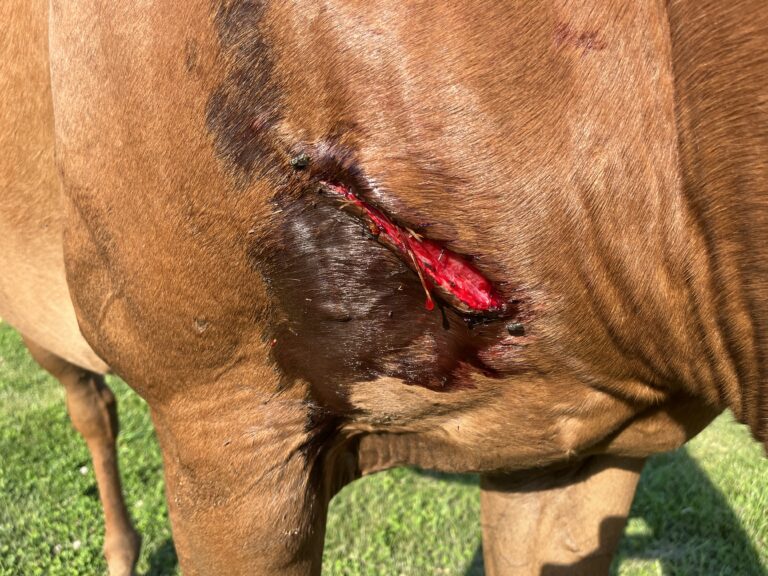The term shipping fever is a general catch-all to describe respiratory disease in horses that tend to occur after they have been transported. The same kinds of disease can occur in other situations as well, but the stress of travel and the conditions horses experience while traveling can often lead to problems.
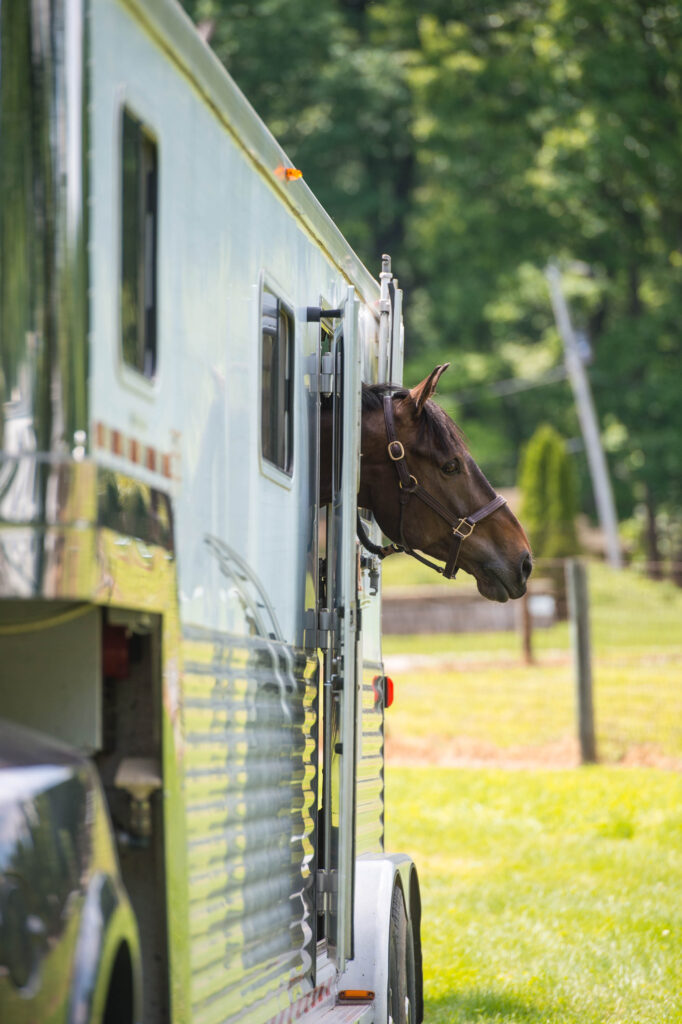
© Amy K. Dragoo
Shipping fever is a bacterial pneumonia, says Dr. Peter Heidmann, DVM, MPH, DACVIM, of Montana Equine Medical and Surgical Center and Palm Beach Equine Clinic in Florida. Pneumonia affects the lungs. Pleural pneumonia affects the chest cavity and the lungs. The severity of bacterial pneumonia can vary greatly, depending on which bacteria become established in the lungs or in the pleural space, despite the surveillance by the immune system. “The most common one is Streptococcus. Streptococcus equi causes strangles but S. zooepidemicus is present in most horses at some point in their lives, growing inside the respiratory tract,” Dr. Heidmann says. “This is considered a normal organism in horses, but if it sets up shop in the lungs, that will cause pathology.” It generally doesn’t cause any problems as long as it stays in the upper airway inside the nostrils.
The horse’s normal immune defenses keep those bacteria from doing any harm in that location. “What we know about this pathogen is that it co-evolved with horses and they are well adapted to it—unless they get rundown and the immune system isn’t as strong as it should be,” says Dr. Heidmann.
“The worst cases are the ones that are not caught early and have other bacteria present. There’s a long list of other bacteria that can be involved but the vast majority of the time it is S. zooepidemicus and most of the time it is confined to the lungs—especially if it’s caught early and treated,” Dr. Heidmann says.
“When it involves other organisms and mixed infections or it’s not caught early, that’s when it becomes more difficult to treat and can also cause more long-term problems,” Dr. Heidmann continued. “It can sometimes cause death if the damage is too severe. In severe cases in the horses that end up surviving, pulmonary fibrosis [lung scarring] can limit athletic performance, sometimes necessitating a change in the horse’s job description.
“One of the things that is important to know about bacterial pneumonia is that it does not transmit from horse to horse or nose to nose. If a horse has influenza [a viral disease], respiratory rhinopneumonitis [also viral] or strangles [bacterial], those organisms are highly contagious [they can go from horse to horse], but bacterial pneumonia generally does not,” Dr. Heidmann explains.
Risk Factors
As the name “shipping fever” suggests, one of the common risk factors for horses getting bacterial pneumonia is recent long-distance travel. “There are a variety of risk factors, but one of them is stress. Shipping fever has become fairly common because today many horses are traveling more miles,” Dr. Heidmann says.
But in addition to travel, there are other situations that can set the stage for this condition. “Generally speaking, horses don’t acquire bacterial pneumonia without a risk factor—or several,” Dr. Heidmann says. “The risk factor could be something like Cushing’s disease that suppresses the horse’s immune response.”
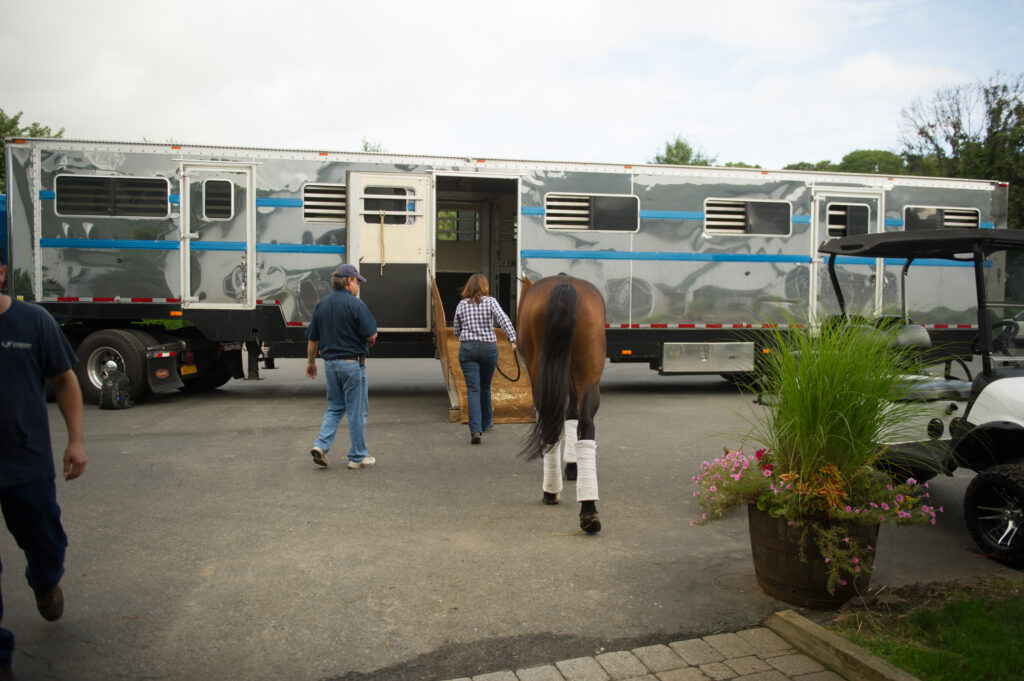
© Amy K. Dragoo
Cushing’s, also known as pituitary pars intermedia dysfunction (PPID), and any other condition that suppresses the immune system will increase a horse’s risk for getting pneumonia, even without travel. “If you add transport on top of that and it’s an uncontrolled Cushing’s disease horse, the risk is substantially higher.”
Similarly, treating a horse with anti-inflammatories such as dexamethasone and other corticosteroids, sometimes used to treat respiratory allergies, such as asthma, can increase a horse’s chances of getting sick when combined with travel. The risk increases when steroids are administered systemically or more than a single dose. “I would not transport any horse within a week of that horse receiving dexamethasone, if I could at all help it. Nebulized and inhaled steroids [which deliver medication directly into the lungs] are a lot safer for the whole horse than systemic steroids in general when associated with travel, but they are also not risk-free,” Dr. Heidmann says.
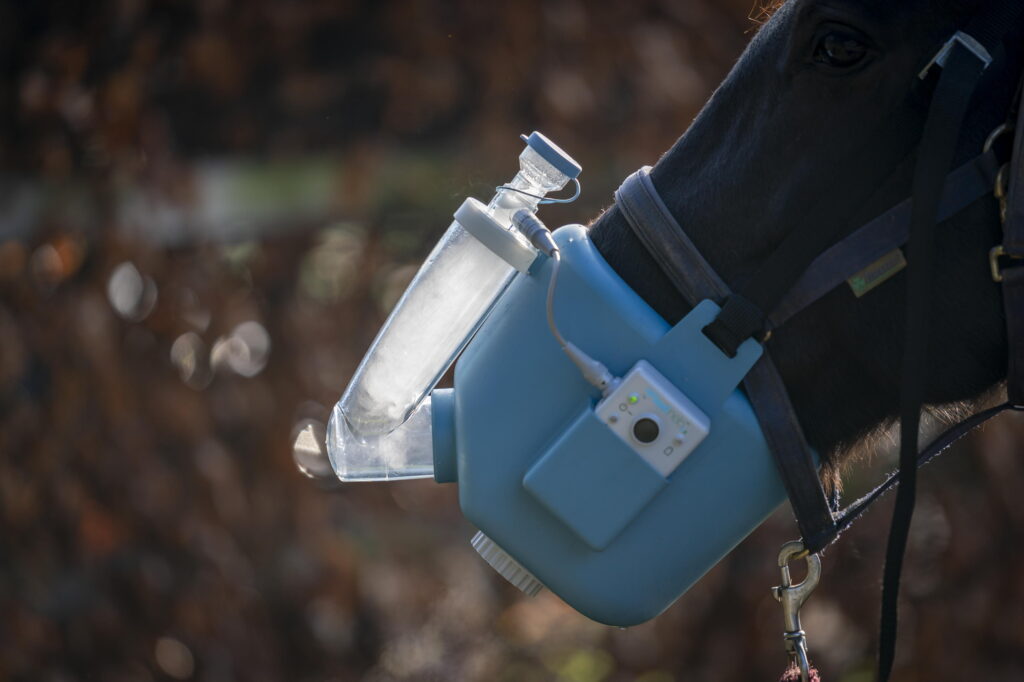
© Arnd Bronkhorst/arnd.nl
“I would recommend first getting the asthma controlled [or whatever you are using the steroid for] and then try to get that horse off the steroid for a whole week before travel. Get where you have to go and then hopefully the air quality is different and the asthma is not coming back. If it does come back, then you treat accordingly—but skip it for a while before you transport the horse.”
Another risk could be any disease that makes the horse more vulnerable. A classic example is influenza, a highly contagious respiratory disease. “The immune system generally clears the influenza, but the short-term damage that the influenza has done to the respiratory system sets the stage for the secondary bacterial infection in the lungs,” he says.
Treatment
When an infection is identified, determining the specific type (or types) of bacteria that are present is important. After that, the next step is identifying the antibiotics that will be most effective via bacterial sensitivity testing.
“If it’s a mild infection, several doses of long-acting cephalosporin will likely be effective. On the flip side, a gram negative or mixed bacterial infection is not going to respond as well to this basic protocol,” Dr. Heidmann says. Some of these bacteria have developed resistance to many antibiotics.
If you have risk factors of concern, the single most important test is to have your veterinarian collect a sample of the respiratory secretions [fluid from the lungs] and have it checked for bacteria. It takes about a week for bacteria to grow. If they do appear, then you can test them against different antibiotics. That way you will know which one or which combination will be your best choice for treatment.”
In the meantime, the horse is usually being treated with some kind of antibiotic while you wait for the results of the culture and its sensitivity to various antibiotics. “If we have reason to think there is something serious going on, due to a fever or from the bloodwork or other imaging tools or coughing or other signs, we don’t wait but start treatment. We have multiple tools to determine what we utilize. One is looking at how the horse responded to the meds we’ve already used and what can we do to approximate those meds long term and what’s happening in the lab with the sample being cultured,” Dr. Heidmann says.
“More often than not, we diagnose a bad case of shipping fever with ultrasound and then X-rays of the lungs. Then we put the horse on broad-spectrum IV antibiotics. That combination is great, but many times the horse will need to be on antibiotics for a month and sometimes longer. In some cases, it makes sense to give that horse potassium penicillin intravenously four times a day for an entire month, and in other cases, that is prohibitively expensive or the owner is traveling and doesn’t want to leave the horse at the veterinary hospital to have IVs for a whole month,” Dr. Heidmann continues.
“Sometimes the horse will go to a lay-up facility to be treated, but usually after the first week of IV antibiotics, we are trying to switch to something that’s more practical for the rest of the treatment. That’s when we often move from an injectable antibiotic—usually to an oral medication or a combination of oral antibiotics,” Dr. Heidmann says.
“Unfortunately, we really don’t have very many antibiotics for horses. There are about 10 that are commonly used, and that’s where we have to determine the best one or best combination we can utilize to target a particular organism.”
Additionally, the lungs can be permanently compromised by the bacterial pneumonia (see box, “Compromised Lung Function,” above). For these reasons, “This is why we emphasize ways to limit the risk of having to go down that path, and this includes prevention,” Dr. Heidmann says.
Prevention
Be aware of the 100-mile rule of thumb regarding risk. Most studies have drawn a pretty clear line that traveling more than 100 miles puts a horse at risk for getting sick. “Some studies say shorter and some say longer, but 100 miles is generally the point at which if you go farther than that, you have to start doing additional measures to decrease the likelihood of shipping fever,” Dr. Heidmann says. If possible, shortening the duration of travel within a day is helpful.
Following travel, take your horse’s temperature twice a day for two weeks. “One of the simplest things to try to catch problems early, is to take temperatures. Not every horse with pneumonia will get a fever, but the ones with a fever are the ones you want to diagnose, and if there is illness, begin treatment right away,” Dr. Heidmann says. “Most horses, when they have early or mild infections, may not have a fever in the morning but they will show fever in the afternoon (usually between 3 p.m. to 9 p.m.). A person should monitor temperature and take it twice a day for two weeks after transport. Many times these infections will show up much later than you’d suspect.” The horse might seem OK for the first few days after transport and then get sick later.

© Amy K. Dragoo
After taking temperatures, if there is any doubt about whether a horse has bacterial pneumonia, with your veterinarian’s help, “there are some quick tests to check white blood cell counts or look at fibrinogen or serum amyloid A. These are good tools to give us an early heads up to know if there is some inflammation in the body,” Dr. Heidmann says.
Allow your horse to lower his head during transport. “If the horse has the right mental character and you have the right kind of trailer or van, letting the horse have freedom of head movement is very helpful,” Dr. Heidmann says. Being able to drop the head, rather than having it tied up, allows the horse to cough or drain out any accumulated mucus or fluid and get rid of the highway dust that might otherwise get into the lungs. This can make a big difference.
“If the horse is of a character that you must have the head tied, or the shipping container does not allow for having the horse loose, then every time you stop for gas or to use the restroom, it’s worth taking time to untie the horse and let him lower his head—or even let the horses out for a few moments to stretch their legs. This is also good for their mental well-being; less stress means lower risk of disease,” he says.
Minimize dust particles in the van or trailer. This includes dust from hay—in a manger or hay net in the trailer. If the horse is inhaling tiny hay particles, this can irritate the airways or even get some of these particles into the lungs if the horse can’t put his head down to cough them out. Hay nets tied high that drop dust and hay particles into the nostrils are a risk. Soaking the hay for a few minutes will help limit the aerosolization of dust particles.
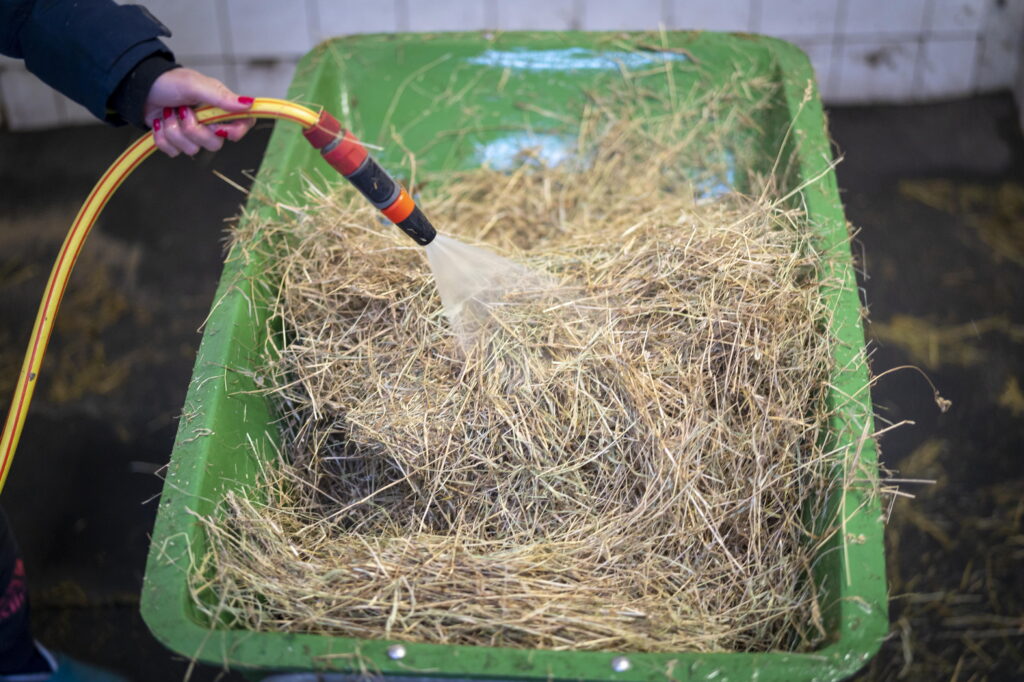
© Arnd Bronkhorst/arnd.nl
Minimize your horse’s opportunity to gobble food. Hay or pellets fed in a manger can also occasionally cause problems if the horse can’t lower his head to cough. A greedy horse may gobble some pellets or a bunch of alfalfa leaves and choke—which might not be a serious problem if the head could be lowered to cough. If the horse has his head tied up or over a manger and can’t lower it, however, fluid and food from an esophageal blockage may back up and spill over into the windpipe and down into the lungs. This is described as “aspiration pneumonia,” which can be fatal.
“This is often the case with aspiration pneumonia, no matter what you do to try to treat it, since usually there is a mixture of all the different germs involved, meaning anaerobic bacteria as well as gram negative and gram positive bacteria. Minimizing the horse’s opportunity to gobble food is important, but you generally want to allow them to eat something,” Dr. Heidmann says.
Most horses will stay more relaxed and less stressed if they get to nibble while traveling. “It’s also physiologically healthy, to keep food in the digestive tract, minimize ulcers, etc. I like to use a small-mesh hay net that acts as a slow-feeder, and the horses can keep nibbling hay. With the slow-feed hay net, they end up eating only about 60 to 70% of their normal diet while traveling, so we are not overloading them, but they are not burning a lot of calories either. This can help keep them eating, but eating slowly, and also minimizes dust from the hay itself,” he says.

© Amy K. Dragoo
Minimize highway dust. “If you are traveling through an area where there are forest fires, for example, you’ll want to shut all the windows on the trailer so there might be less smoke and ash coming into the trailer.” Anything that can be done to minimize the dust that could compromise respiratory health is crucial. This might affect the route you would travel, or the days you might travel, to avoid problems—even if it means waiting a whole day somewhere and then hitting the road again after the storm is gone or the air quality has otherwise improved.
“This is worth it when you think about the potential risk and huge expense involved when treating pneumonia, versus preventing it,” Dr. Heidmann says. “The competitive event you had your heart set on may not be worth risking the future health of your horse. It can be hard to see it that way when most of us want to get there and do the event. If you will be traveling through regions that might have fires, look at the fire maps and weather predictions.”
Place horses familiar with one another together. “Transport for a horse is similar to us getting on an airplane,” he explains. We want to be in our comfort zone to the greatest extent possible when crammed into close proximity with other people, like being in a cattle car. “Having horses familiar with one another when traveling helps, like having familiar humans with you when traveling.”
Vaccinate your horse. Shipping fever organisms can’t be prevented directly, but some diseases like influenza and respiratory rhinopneumonitis (herpesvirus) can be prevented with vaccination. “This can keep these viruses from setting the stage for a secondary bacterial infection. Keeping vaccinations up to date can be helpful,” Dr. Heidmann says. Consult with your veterinarian regarding a good annual vaccination schedule for your horses, taking into consideration their individual risk factors.
In summary, the takeaways to prevent shipping fever are decreasing the duration of travel within a day, letting the horse have its head free, vaccinating and paying attention to overall health. “Health screening makes a big difference. You definitely want to avoid having a snotty-nosed horse get in the trailer with your horse because you don’t know if that horse might have rhino or some other contagious disease,” he says.
Determining Bacteria Types
Growing bacteria in a petri dish to determine the type is a time-consuming process. “Bacteria want to grow in a horse more than they want to grow in a lab, and there will be some cases where you won’t be able to grow anything even when you know there is something there. Also, it takes about a week—five to seven days in most cases—to grow,” says Dr. Peter Heidmann of Montana Equine Medical and Surgical Center.
“I sometimes tell clients that the lab is not dragging its feet. It just takes time, like growing a tomato in your garden. You first have to grow the plant, and then the fruit, and then the fruit has to ripen. We are growing bacteria in a dish and then it has to actually create colonies.
“Then we need to test those colonies against different antibiotics and this adds another 24 to 48 hours to the process. This is not essential in every case but can be extremely helpful on the bacteria that have resistance to most antibiotics,” he explains.
Compromised Lung Function
There are cases in which your veterinarian can clear the entire bacterial pneumonia and it is resolved, but there is still so much inflammatory debris remaining in the lungs that they are permanently compromised. “There may be a lot of fibrin, protein or even scar tissue left behind after the infection is cleared,” Dr. Peter Heidmann explains. The lung function and capacity may be compromised long-term.
“In many of those cases, we have to do surgery to take out some of the residue from the infection. The bacteria are gone, but what they left behind are giant gobs of protein and white blood cells that the body can’t clear. These can mature into scar tissue and cause serious restrictions in lung function,” Dr. Heidmann says.
This material has to be removed, and this is typically accomplished with standing surgery involving rib resection. “This is where you have to remove a rib to access the chest cavity enough to remove the protein and clot material, to allow the lungs to have normal movement within the chest cavity. This kind of major surgery makes sense for some horses but not others because these cases can be very complicated. The horses in those cases may have already had 60 to 90 days of varying antibiotics because it can take that long to sterilize the chest cavity and clear the infection. There may have been chest flushes, etc. and then if you add surgery on top of that it can be very expensive,” he says.
About Peter Heidmann, DVM, MPH, DACVIM
Peter Heidmann is the founder and hospital director of Montana Equine, an equine referral hospital and comprehensive medical and surgical practice with locations in Billings, Bozeman, and Helena, Montana, and well as Bellevue, Idaho. He also serves as head of internal medicine at Palm Beach Equine in Wellington, Florida. Dr. Heidmann provides seminars on internal medicine topics for horse owners and veterinarians, consults on medical cases and has twice served as the primary consulting medicine specialist for the Pan American Games. He most recently covered this role at the Central American Games in the Dominican Republic.
This article originally appeared in the Winter 2023 issue of Practical Horseman.





